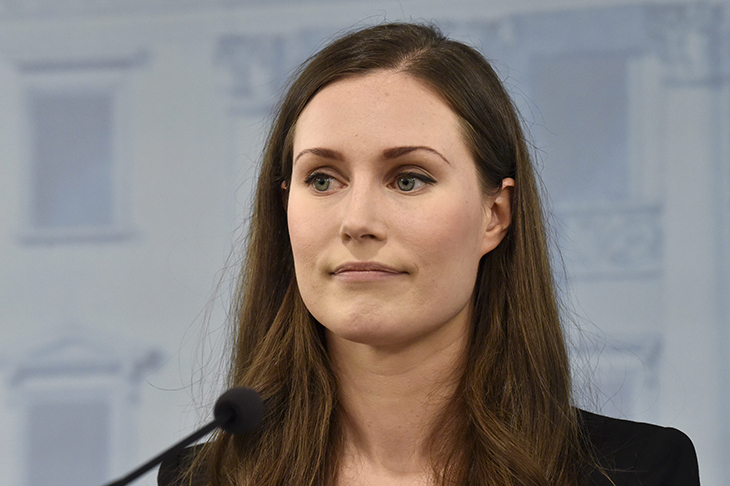Helsinki
Sanna Marin is the world’s new feminist political icon. At the age of 34, she’s just been appointed the prime minister of Finland after a power struggle in the five-party coalition government that forced Antti Rinne out of office only six months after he won the general election. Marin isn’t just young and a woman — she was brought up by two mothers in a small town south of Tampere, an industrial region that isn’t known for championing progressive values. That backstory has earned her the plaudits of feminists on both the left and the right. To the Daily Telegraph, she’s a ‘trailblazer’. For the Guardian, her coalition of women-led parties reminds us ‘that another politics is possible’.
The Finns, however, are far less excited. Women politicians are hardly a novelty in Helsinki: they have had two female prime ministers and one female president in the past 20 years. Three of the four last cabinets had female majorities, and there was already a strong group of young women in the cabinet before Marin moved into the Government Palace. They are still around. The education ministry is run by Li Andersson, 32, who has led the Finnish left since she was 29. Maria Ohisalo, Green party leader, is 34 years old and heads up the Home Office. And the center of political attention in the past weeks has not been Sanna Marin but Katri Kulmani, the 32-year-old Center party leader who led the campaign to depose the last PM. She is now the new finance minister.
Identity politics hasn’t really taken hold in Finland. In Helsinki this week, several commentators were alarmed at the ‘Behold! Women!’ tone of the global media coverage. One Finnish politician, a darling of the European left, even complained that ‘It’s unfair that she is praised only for the fact that she is young, a woman and has lesbian parents, which are all factors that Sanna couldn’t influence herself.’
She has a point. Marin’s background and gender are far less interesting than her character and accomplishments: she is an inspiring person who has packed an extraordinary career into just a few years. She was at the helm of her party’s election campaign earlier this year and has served as a minister for transport and communication under Rinne. Before that she ran the city council of Tampere, Finland’s largest city outside the capital region, for four years.
Her problem now is that, while Finns like her profile, they’re not wildly keen on the government she now leads. Her party, the center-left Social Democrats, has been tanking in the polls (which partly explains why her predecessor was dispatched so quickly). They won less than a fifth of the vote back in April, which was still enough to lead a five-party coalition. Then came a pledge to make Finland carbon-neutral by 2035, but Finns baulked when they saw the bill for having the most ambitious climate target in the world. A recent postal strike made the government look amateurish. To this we can add unemployment standing at twice the level of other industrial eurozone countries like Germany and the Netherlands. Economic growth has slowed.
Finland’s general problem was summed up by Alex Stubb, its former PM, who once quipped that the iPhone killed Nokia and the iPad killed the paper industry. That’s all too true. Ever since the financial crisis, the Finnish economy has been struggling to pay the bill for its welfare state — or meet the pay-rise demands of the unions.
When Rinne was elected in the spring, he promised change and an economy that worked ‘for the many’. A trade-union man, his job was to bring back to the fold all the disaffected blue-collar voters who had fled to the Finns party (previously known as the True Finns), the nationalist populists who are now leading in the polls. In an attempt to hold the coalition together, Rinne veered between left-wing, blue-collar populism and obscure appeals to the green, metropolitan liberals. He ended up coming across as a fraud and a fool — he was never going to last long in office. The Social Democrats collapsed because, in him, they had an insipid prime minister schooled in the era of cross-party sauna politics. This is a failing model.
That’s why the most popular politician now is a balding 48-year-old linguist, Jussi Halla-aho, the leader of the Finns party, who represents a brand of blunt and incendiary populism. His party has almost twice as much support as the Social Democrats under Sanna Marin.
Finland is rebooting its politics. As in so many European countries, the Finnish establishment response to nationalistic populism has been still more urban centrism. It’s purist rather than pragmatic — and, as a political movement, it’s elitist: for the few rather than for the many.
More than anything else, the new centrism is defined by youth. The old guard are on their way out. They came of age in an era of pragmatism and compromise, and now struggle to speak with a clear voice and deliver a message of purpose. This is something younger leaders find it easier to do.
Marin might soon lose her crown as the world’s youngest leader. Austria’s Sebastian Kurz, who hunts in a different part of the jungle, may soon be back in office, depending how coalition talks go. He’s 33. And then there’s Greta. The point about her is not so much the message — it’s more about her young, innocent, passionate and uncompromising persona.
Finland kicked out old Rinne, and is sloughing off the tired politics he represents. Now they are getting the clarity and purpose of young Sanna. She represents a green and tech-friendly social liberalism, backed up by more taxes and spending. That shift ultimately may reconfigure Finland’s political landscape. It’s an experiment — and one that could easily backfire in a country whose rapidly ageing population is jaded about politics. But the Finns have a proverb for the experiment. Naiset ensin, vaikka heikoille jäille. ‘Ladies first, even on to thin ice.’
This article was originally published in The Spectator’s UK magazine. Subscribe to the US edition here.



















